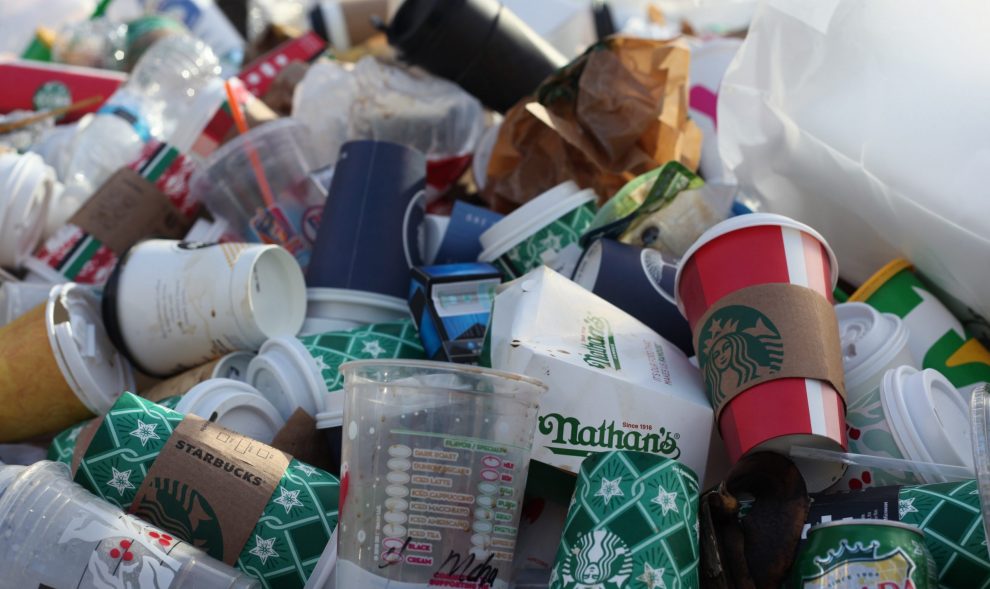Talking about faith and plastic together seems like talking about apples and oranges. Or two even further extremes: maybe apples and giraffes. But for Sasha Adkins, a lecturer at Loyola University Chicago’s Institute of Environmental Sustainability, the two go hand in hand.
Inspired by working at a birth center in El Paso, Texas and seeing how the local air and water pollution caused high rates of birth defects and miscarriages, Adkins originally entered graduate school to get a Ph.D. in environmental health. But after years of studying the toxic chemicals in plastic, Adkins says, “I couldn’t keep going. I was so depressed. I didn’t smile anymore. It was really disheartening to spend so much time examining the negative effects of these chemicals.”
The response of Adkins’ advisor was simple: Think about how the science relates to the rest of your life. Today, this approach continues to be at the center of Adkins’ classes. “We talk about the physics and chemistry of climate change,” Adkins says. “But we also talk about solastalgia, or the emotional distress we feel as we watch the environment we love being destroyed.”
To really make progress in solving the environmental crises we’re facing today, Adkins believes, we need both science and ethics. “As we move forward in this planetary crisis, we need to bring our whole selves to the table,” Adkins says. In other words, we can’t talk about science without religion or emotions.
In Adkins’ book, From Disposable Culture to Disposable People (Wipf and Stock), the first half focuses on the science of plastics: how plastic molecules affect the human body and why they’re so dangerous from an environmental and public health perspective. The second half, however, switches gears and centers around the spiritual impact of plastics. If we’re going to truly honor the value of all life, Adkins argues, we have to stop acting like things—and, by extension, the people who produce them—are so disposable. And nowhere is this more obvious than single-use plastics.
What should people know about the science of plastics and waste?
The problem starts with how plastics are manufactured and what they’re manufactured from. It’s not like there are plastics and then there are some toxic chemicals that may be added to some plastics. Plastics are toxic.
Scientists did a study where they submerged polyethylene and polypropylene pellets—both of which are considered fairly benign plastics—in a mesh net in the ocean and measured the chemicals in them before and after. They realized that the pellets were taking up contaminants from the ocean. Which, on one hand, is fantastic: We could filter ocean water. But then, on the other hand, where would we put these pellets that will last forever?
This was the first study to show that plastics aren’t just a physical problem. We talk about sea animals getting entangled or choking because of plastics. But they also capture lipophilic pollutants—or chemicals that dissolve into fats—and concentrate them, and this eventually makes its way into our food web
Other studies have found that there are micro- and nanoplastics in our soil, in the rain, and in the air. Everything we grow is impacted. Bisphenol A (BPA), the building block of polycarbonate plastic, interferes with the communication between a plant’s roots and the rest of the plant, for example.
What about biodegradable or compostable plastics?
Plastic can’t be endlessly recycled: It lasts forever. You can downcycle plastic or upcycle it into art or books, but it lasts forever. It’s not like glass or aluminum, which can be efficiently reused. And studies have shown that some of the bio-based plastics are even more toxic than the conventional ones.
I’m working on a study now where we’re studying perfluorinated compounds like Teflon—it’s used as the coating in nonstick pans and to coat compostable to-go containers. These compounds don’t break down; they’re called forever chemicals. And we have found that when we compost them they are taken up by cruciferous vegetables and kale into the edible parts of the plant. One of my students is composting the containers used on campus and growing food in the resulting soil, then measuring where these chemicals end up in the plants.
How can we limit our exposure given that plastics are so ubiquitous?
I would really love to shift the focus of the conversation from what we can do to protect ourselves to what we can do to protect the workers who are involved in making and disposing plastic, because they are the most directly impacted. While I would love to see us move away from producing toxic products, meanwhile we should pay more attention to the impacts on workers in frontline communities.
Right now a lot of plastic is manufactured overseas in countries that don’t have the same limits on exposure in the workplace or follow-up
medical care.
When I worked with farmworkers, I had to warn them, “Don’t hug your children when you come home until you’ve taken off your work clothes and taken a shower. Wash your clothes separately from your family’s laundry. The chemicals are on you, but also in your breath, in your perspiration.” It was heartbreaking.
What’s keeping us from having this conversation about workers’ health and dignity?
In my book I talk about how people get more upset about an image of a sea turtle with a straw in its nose than a picture of kids who live and work on a giant waste pile. In my book I cynically explain that I think it’s about blame: It’s so overwhelming for us to think about the problems our lifestyle is causing. It’s easy to understand that the sea turtle did nothing to deserve its plight, but there’s a defense mechanism to say about people, “Well, they should have chosen a different life. They should have learned another trade.” And we don’t realize that the reasons this waste pile exists are the same reasons that these children don’t have other opportunities; this is not their fault.
I went to a zero waste conference once during which we all discussed the need for regulations around BPA. I brought up that some of the people who are most affected are cashiers: BPA is in cash register receipts, and cashiers are absorbing the chemical through their skin all day. The other participants looked at me and said, “Workers’ health isn’t sexy.” Someone actually said, “I only care about myself and my family.” I really want that to shift. We have to love our neighbor as ourselves.
Do individual actions have a purpose?
Individual solutions are useful to me because they show me the limits of individual action. They show me where I need to push.
For Lent I try to give up something that I think is coming between me and God. The hardest year was the one when I tried to give up guilt: I had to repeat it another year. Guilt isn’t useful. I don’t want people to think that there’s nothing that can be done, but I also don’t want them to think that tiny, individual actions are enough. Our individual actions show us how flawed the system is, and then we can work together to change that system.
It’s important to remember that what we see in our own plastic use is only the tip of the iceberg. Whether we choose to use a metal straw or a reusable water bottle, 99 percent of our plastic consumption is invisible to us.
It’s not just about replacing one molecule with another; we have to look at our relationships with one another.
How did plastic come to represent these broken relationships?
There’s this separation inherent in how we think about plastics. We don’t want something that anyone else has touched; it has to be sterile and new. And then when I’m done with it, I’ll throw it away so no one else can have it.
I keep coming back to the image of the Eucharist and the chalice. We all drink from the same cup. It passes from hand to hand. There’s a relationship there. But disposable culture will have none of that; instead, it’s about individual little packets of the host in sealed plastic wrap.
When I worked in a midwifery clinic, one of the apprentices was afraid to touch a birthing mother. She put on a glove to pat her knee and reassure her during labor. This fear of each other and fear of commitment is about broken relationships, and that’s what I think is at the root of disposable culture.
There’s this ad for apple slices that are wrapped in individual plastic packages: “When a whole apple is too much of a commitment.” But if that whole apple is too much for you, why not share it? It’s all about relationships.
What’s your reaction to things like that?
It’s hard not to get angry. But that doesn’t heal broken relationships. I try to keep in mind that my intention is to be more faithful rather than to change the world though my own individual actions. What am I angry about anyway? At apathy? That this system exists in the first place?
I struggled so much with anger that I went on a silent retreat. And I realized that it’s OK to embrace the anger: It’s like pain, it tells you that something is wrong. So now I pray to myself: “Brother rage, Sister fury, help me to recognize injustice.” I try to make anger a tool instead of just something to wallow in.
Where do you find God in the midst of these broken relationships?
Once, when I was a full-time volunteer, a woman came up to me and asked me for money. I actually had an overdrawn checking account at the time and I told her, “I don’t have anything to give.” But then I thought again, and said, “Wait, maybe I do. I don’t have money, but what do you need?” She said, “A hug.” I replied, “Me too!” And so we hugged. And we both started crying. She told me, “Thank you, I really needed that.” And I said, “So did I.” We never saw each other again, but that connection was so powerful. I was feeling really depressed at the time, and she saved my life.
The times when I have felt closest to God are in relationship with the people whom society says are the most disposable. When I’m at the end of my rope, it’s harder to connect with people who seem to have the perfect façade. So I find myself sitting on the curb with folks who are not housed and just sharing a meal. I used to sit with a woman in New York City; we’d watch people go by and think, “Why are they in such a hurry?” We’d sit for an hour or so together, not talking, just resting in each other’s company. I felt so held and loved; that’s when I felt like I was meeting Christ.
This was the opposite of what I’d been taught to expect. I thought I was the helper, and that my presence was a comfort to those who were somehow less fortunate. But really it was the other way around.
I sometimes wonder if Jesus wanted to have dinner with people who were at the margins of society because it allowed him to get past all the polite conversation. Instead, he went to where he could be really heart to heart, connected, places where people weren’t sure they’d be alive tomorrow. It opened him and the people around him up to encountering one another. It’s how Jesus talked about himself: I am the stone the builders rejected.
All things are good. All things work for the good of God. Nothing is waste or trash. No one is beyond God’s love. That attitude conflicts with today’s disposable culture, and it’s in those places of tension where there’s room for change, like the walls falling down around Jericho.
How do you keep from getting overwhelmed in the face of this huge problem?
I try to remember that it’s not my job to fix it. There’s a quote attributed to Mother Teresa: “We are called upon not to be successful but to be faithful.” I feel like my job is to celebrate God and life, and that’s enough.
Everyone is harmed by disposable culture: from the people who produce plastics to the wealthy people whose identities are so attached to these disposable things. It’s painful to see, and it’s much more painful to realize how sucked into this system I am. But with every breath I take, the Spirit enters and sustains me, and I have the opportunity to do something different tomorrow. This is not the end.
What is oppressive will destroy itself, because it’s not built on the foundation of God. So my goal is to build something new: something beautiful and wonderful that I can invite others into. In and of itself it may not be big enough or strong enough to compete with the destructive systems of consumption, but it can still reflect what the beloved kingdom will look like someday. That’s what we can do.
What we’ve been given is wonderful, so let’s be caretakers the best we can. I think of creation like tending a garden; if some kids come running through and smoosh all the little flowers because they’re playing ball, I don’t get mad or give up. I continue to garden anyway. The act of caretaking changes us. It’s a form of prayer. It’s a form of worship. And if we do that, God will take care of the rest.
This article also appears in the April 2020 issue of U.S. Catholic (Vol. 85, No. 4, pages 24-27). Click here to subscribe to the magazine.
Image: Jasmin Sessler on Unsplash













Add comment